30+ Sample Inventory Lists
-
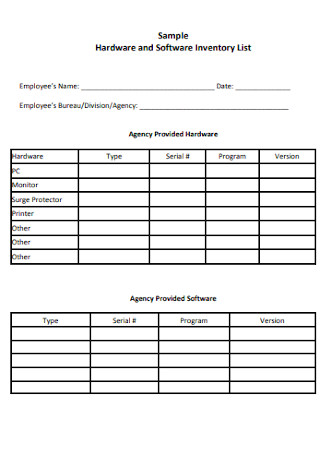
Software Inventory List
download now -
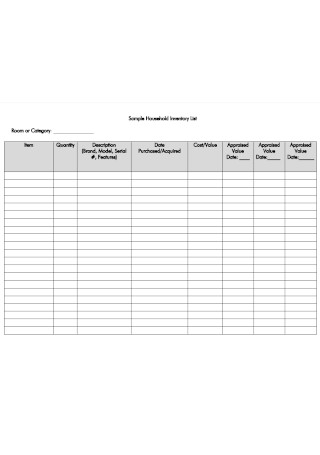
Sample Household Inventory List
download now -

Equipment Inventory List
download now -
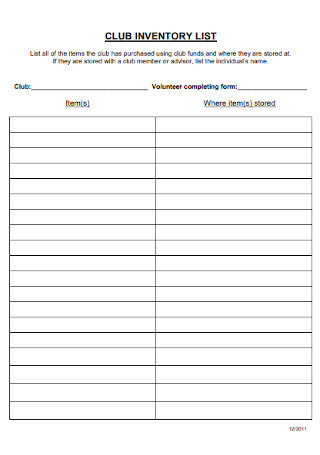
Club Inventory List Template
download now -
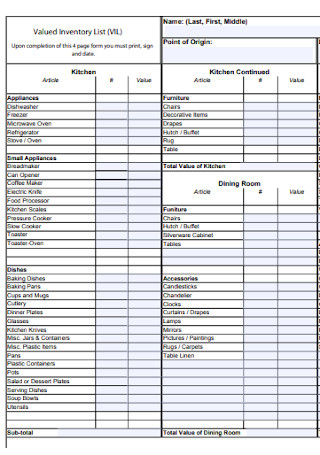
Valued Inventory List
download now -
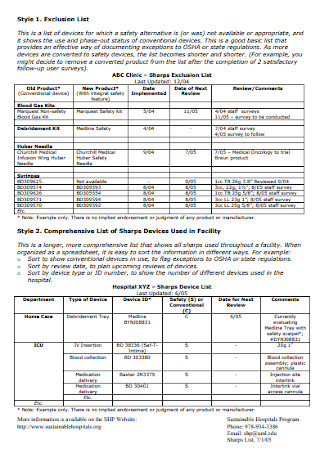
Inventory List Format
download now -
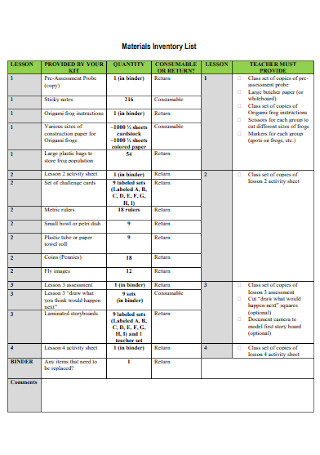
Materials Inventory List
download now -
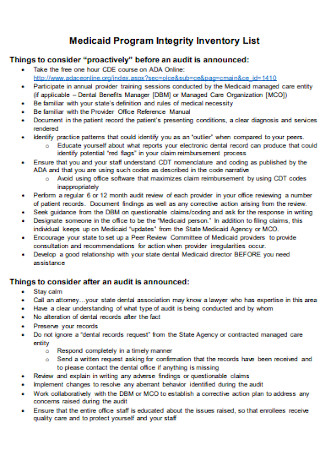
Medicaid Program Integrity Inventory List
download now -
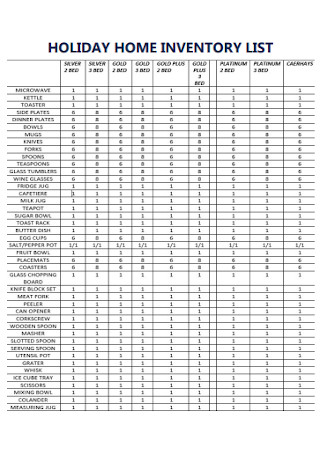
Holiday Home Inventory List
download now -
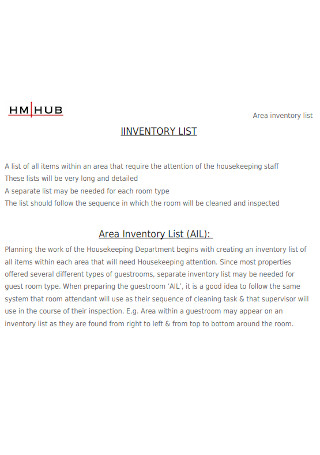
Area Inventory List
download now -
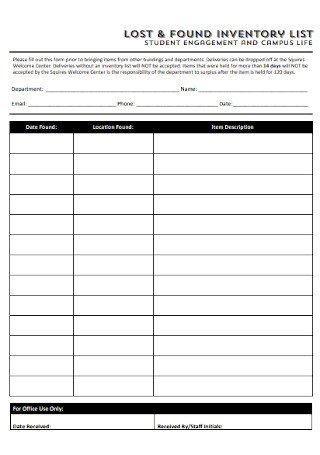
Lost and Found Inventory List
download now -
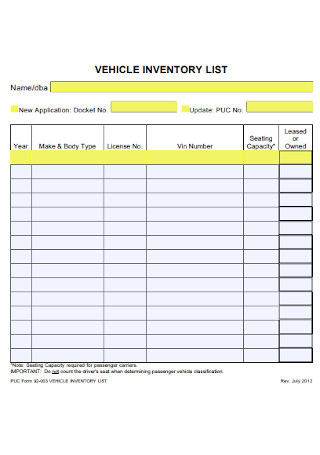
Vehicle Inventory List Template
download now -
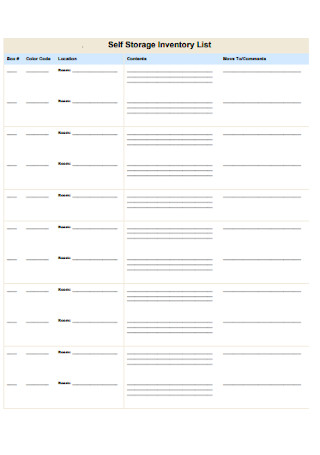
Self Storage Inventory List
download now -
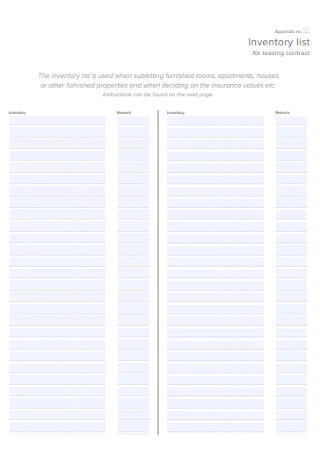
Inventory List for Leasing Contract
download now -
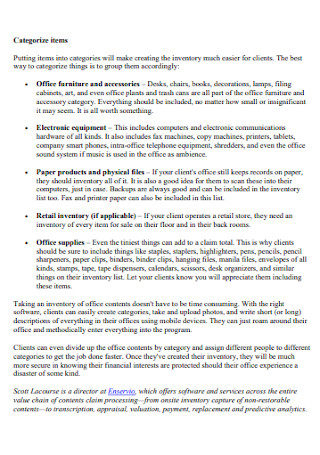
Office Inventory List
download now -
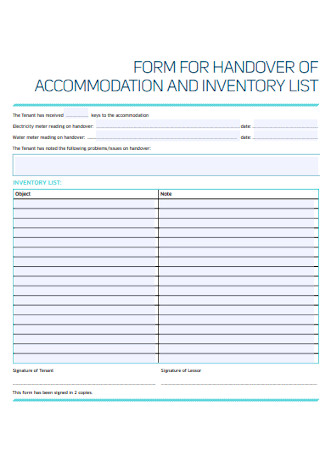
Inventory List Form Template
download now -

Farmers Market Inventory List
download now -
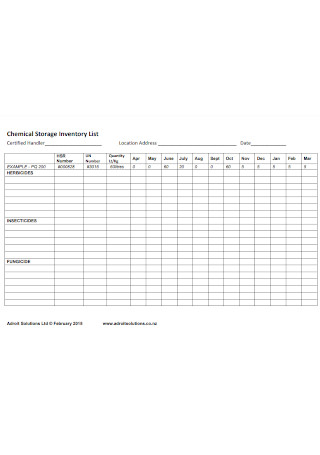
Chemical Storage Inventory List
download now -
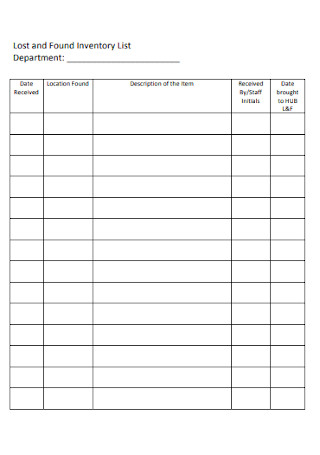
Found Inventory List Template
download now -
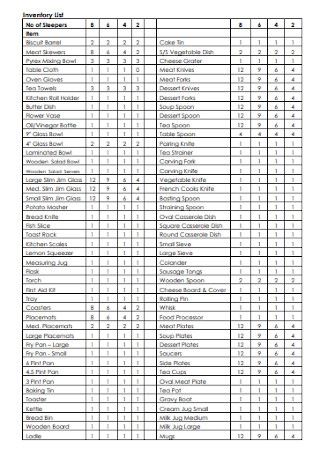
Simple Inventory List Template
download now -
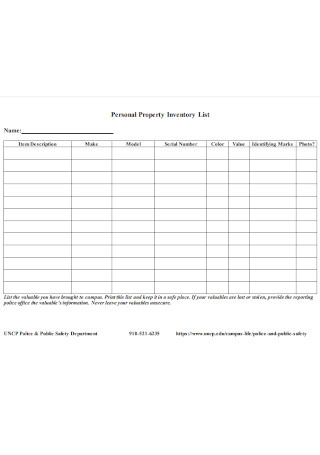
Personal Property Inventory List
download now -
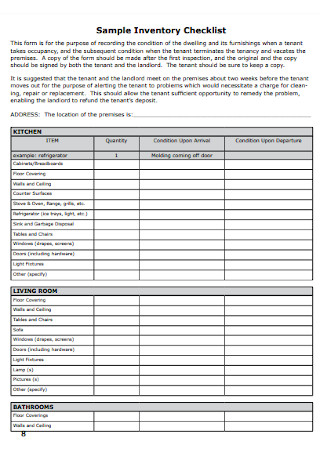
Sample Inventory Checklist
download now -

Formal Inventory List Template
download now -
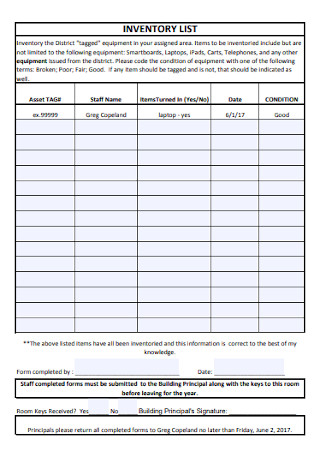
Standard Inventory List Template
download now -
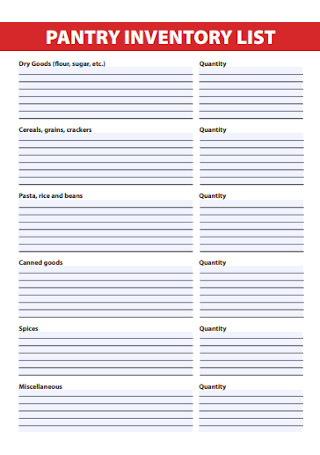
Pantry Inventory List Template
download now -

Card Processing Equipment Inventory List
download now -
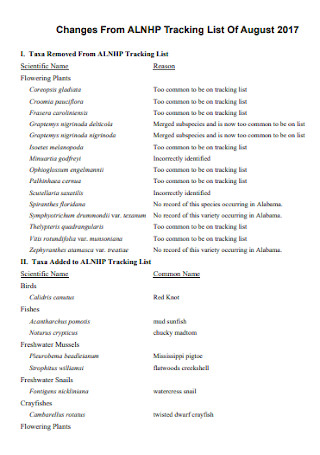
Printable Inventory List Template
download now -
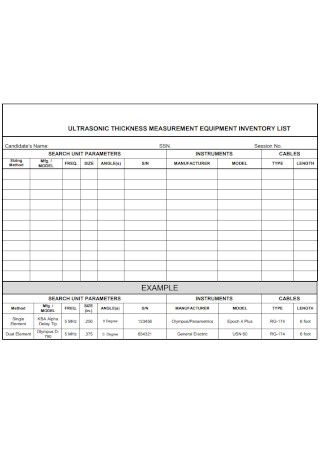
Measurement Equipment Inventory List
download now -
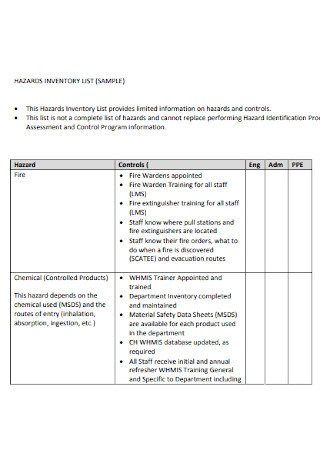
Hazards Inventory List
download now -
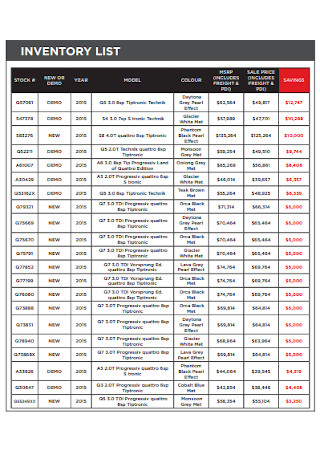
Cars inventory List Template
download now -
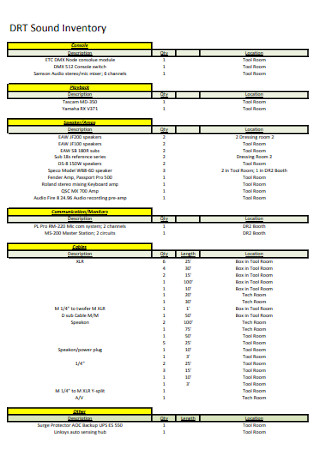
Sound Inventory List Template
download now
FREE Inventory List s to Download
30+ Sample Inventory Lists
What Is an Inventory List?
Benefits of an Inventory List
How to Create an Inventory List?
How Inventory Works
Other Uses of Inventory Lists
FAQs
What types of information are recorded in the inventory list?
What is an inventory item?
Why is it important to keep the inventory list updated?
What is an inventory report?
Can inventory sheets be shared?
What Is an Inventory List?
An inventory list is a document that contains items that you need to restock from time to time. Inventory lists are useful tools in monitoring item stocks that are essential in the operation of the business. These items on the inventory list need to be checked regularly and must have a complete list of all your stocks.
Your inventory list also needs to be updated in the spreadsheet to ensure that you will not be low on supplies as well as have a clear picture of how your business is doing. Not only does it inform you that it’s time to place new orders, but it also gives you an idea of the sales trend and takes note of what items are fast-moving or slow-moving. In essence, an inventory list contributes to increasing your profit by minimizing losses and selling more items.
Take note that an item can only be considered on the inventory list of a business if it is directly involved in the business that the customers will buy. Cleaning supplies in the store or office and equipment and furniture are all considered business assets, but not inventory items.
Benefits of an Inventory List
As you already know, inventory lists are very useful in running your business. But there remains a shocking number of small businesses that do not have inventory management put in place. About 46% of SMBs either do not track their inventory or use a manual method. This should not be the case for you. You should know that including inventory in your operations will help you keep your business organized and keep track of items on hand or if you’re low on stocks and time to place an order again. Creating this type of stock inventory list proves to be beneficial. Some other benefits of having an inventory list are as follows:
Maintain a Balanced Inventory Items
When an inventory list is regularly updated, you don’t have to buy so many stocks when you don’t need to as well as reduce the risk of running low or out of supplies. The great thing about an inventory list is that you don’t have to check on your stocks or supplies every day. Setting a schedule for doing an inventory is sufficient to monitor stocks effectively and efficiently.
Manage Inventory Turnover Better
With a proper list, you will be able to analyze trends of patterns of your product and stock movements. Being able to predict turnover, you can start to use your resources more effectively. When you do this, you also prevent products from spoilage from being stocked for too long or becoming obsolete and irrelevant to your customers.
Keep Customer Satisfied
One way to keep your customers happy and satisfied is to provide them with a fresh stock of goods. By managing your inventory list well, you will be able to deliver quality products and meet their needs.
Inventory lists can minimize mistakes in the delivery of orders such as damaged goods or sending the wrong orders, all together. Using inventory lists through an inventory management platform can help you provide a positive experience for your customers and create brand loyalty.
Help You Plan More Accurately
It doesn’t matter what the inventory list is for, what’s important is that you can use it when you’re planning. At work or in your business, an inventory list can help you plan the items that you need to restock when you need to restock, and how many you need to purchase.
Even at home, when you plan to go shopping for groceries or other household items, an inventory list will help you shop more efficiently and be more organized during your shopping trip.
Better Stocks Organization
Your inventory list will allow you to organize your items and stocks in your store better as well as your possessions at home. It will also help you locate things easily by referring to your list by storing them in different places and noting them on your list. You can also organize your items in a certain way to look more aesthetically appealing to the eyes.
Save Your Resources
Inventory lists and templates can save you so much time and money. You don’t need to keep counting items every day to ensure that you’re not running out of stocks and you still have enough for the day. All you need to do is to review your list and keep it updated regularly.
Aside from time, it can also save you a lot of money. An inventory list, may it be a beauty supply store inventory list or a stock inventory list, tells you exactly how much you need to buy so you don’t have to spend more than you need to. In running your business, one way to earn a profit is to sell items that fly off the shelves and refrain from displaying items that don’t sell at all.
How to Create an Inventory List?
There are many inventory list templates readily available for you. You can find and download an inventory list template that suits your business well or you may also opt to create your own from scratch. To make your own inventory list for your business, read below our step-by-step instructions.
Step 1: Open a New Spreadsheet
The first step you need to take is to open a new spreadsheet file in Excel, Google Sheets, Numbers, or another program that you are comfortable using to create your inventory form. The features in each program may be slightly different from each other but the process of creating one is essentially the same for all and it shouldn’t matter which program you choose. Just make sure that it is accessible to you, easy to edit and save your inventory list.
Step 2: Label the Headings of Your Inventory List
Once you have a blank sheet with you, the first thing you need to do is to name each heading for each column in your inventory list. You may add any label that you want as long as it is relevant to your business and it is easy to understand.
As a tip, customize your headings labels based on the type of business that you are managing and the inventory management priorities that you have set. Heading labels like product descriptions help identify different types of products.
Step 3: Enter Items in Their Corresponding Information
Setting up your inventory list will take a while to finish since you have to enter every item and their corresponding information for the first time in the form that you just created. You will notice that in the succeeding days or periods, some of the information will not change but your inventory levels will go up and down depending on the availability and movement of your stocks and supplies.
Step 4: Save You Inventory Sheet and Update During Inventory
After creating your inventory list, this can serve as your template in your succeeding inventory lists. You may even set it up as an inventory printable sheet and create copies of your inventory. Once it has all the necessary information and all categories and products are filled in, make sure that you save it. Keep it in an organized folder and it should be in an accessible place, in your primary work laptop, or back it up in a digital storage or portable storage device.
When you do your weekly or monthly inventory check, you can use your inventory list to update your records and track all changes in your supplies.
How Inventory Works
The inventory process is fairly straightforward and goes like this:
- Receipt of wholesale products or components from your vendors or suppliers.
- Resale of products either as it is or altered, combined, repackaged, or prepared for display to the customers.
- Receipt of orders from customers who wish to buy your products.
- Receipt of payment of sales which can be allocated for placing another order.
Other Uses of Inventory Lists
It is widely known that inventory lists are crucial in business operations. But what other times can an inventory list be used? You can make different types of lists and there are so many inventory list templates available online even for your own personal use.
Inventory List at Home
If you live with other people, a home inventory can help you keep track of your personal belongings as well as the shared items in the household. Moreover, you can also have an inventory list of your pantry staples to ensure that you will never run out of stocks.
And should you decide to move, you may create a moving inventory list to help you check if you were able to bring with you all of your items when you moved.
Inventory List Outside of Home
Outside your home, at your workplace, having an office supply inventory list makes it easier for you to know if you’re low on office supplies and if it’s time to request for more. It also helps in the proper accounting of purchases as assets or liabilities under an accrual system of accounting.
Aside from the workplace, an inventory list is also useful in school when storing items used in laboratories, gyms, and classrooms.
These are just some inventory list examples and their uses. But the key takeaway here is that a proper inventory list makes the process considerably easier.
FAQs
What types of information are recorded in the inventory list?
Information found on each inventory list differs from each business. However, some of the most common information are:
- Inventory item name
- Serial number
- Price per unit
- Number of units in stock
- Sale price
- Order time
- Supplier information
What is an inventory item?
Inventory items are products that your business purchased for resale. These inventory items are usually bought wholesale or in bulk and sold to customers in units without any changes to the product. It can also be altered or combined with other pieces to create a new product that can be sold to customers.
Why is it important to keep the inventory list updated?
An updated inventory can help you:
- Ensure accurate forecasting of product trends
- Manage assets properly like machinery, furniture, and product displays
- Sell goods in chronological order to prevent spoilage and stacking up of old supplies
- Ensure that the quality of products is monitored and controlled
What is an inventory report?
An inventory report is a summary of the amount of inventory your business currently has. It is a record of the figures that represent the products you sold, the number of products you’re ordering, or the inventory you need for your internal business. It should have up-to-date information, complete with details and visuals to make it clearer and easier to understand.
Can inventory sheets be shared?
Yes. Inventory sheets can be shared with your employees or colleagues so that they can open and update the list as scheduled or when needed. Keep in mind that any changes to the copy of your inventory list file will not modify your original file. Always refer to the most recent version of your list when making a decision about your inventory.
An inventory is anything that a business acquires to resell to customers. Tracking your inventory is key to business success in retail, wholesale, and manufacturing and this is possible with the help of an inventory list. An inventory list is not just used for business operations but is also applicable in home and daily living. Having an inventory list makes it easier for you to manage your inventory properly to prevent overspending on unnecessary product orders or running out of inventory stocks for your business needs.
